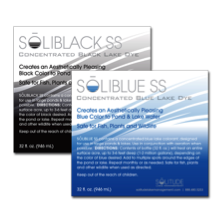By Industry Expert Greg Blackham, Aquatic Specialist
 Keeping up the appearance of your pond or lake and maintaining a healthy ecological balance can be frustrating at times. Far too often it may seem as if reactive pond management is being applied to control arising problems. One simple, yet highly productive proactive practice, is controlling the amount of sunlight entering your pond. Lake dye is an extremely cost-efficient way to achieve this goal.
Keeping up the appearance of your pond or lake and maintaining a healthy ecological balance can be frustrating at times. Far too often it may seem as if reactive pond management is being applied to control arising problems. One simple, yet highly productive proactive practice, is controlling the amount of sunlight entering your pond. Lake dye is an extremely cost-efficient way to achieve this goal.
Whether the lake/pond was man-made or created by Mother Nature, there are probably shallow areas somewhere in the body of water, especially around the perimeter. These zones are the most susceptible to algae and aquatic weed growth.
Most plants and algae require sunlight for growth through photosynthesis. In the electromagnetic spectrum, some wavelengths are more valuable than others. The strongest inhibitor of these UV penetrations is the color blue, hence the most common lake dyes used are blue, although black and other colors have been reported to be successful under the right conditions. Even if the lake or pond is not particularly shallow, one may be surprised how far down the column of water UV penetration can occur.
The key to implementing this strategy in your lake management program is maintaining a constant UV screen, not just in the spring, when the majority of growth begins. We accomplish this by applying the dye regularly throughout the year, even in the winter months. This also creates a constant color for your lake or pond that is pleasing to the eye year round. Who would have thought the most effective color in the management of sunlight in your lake or pond would look great too!
Finding the correct amount of dye to add initially and in subsequent applications throughout the year can be tricky at first. Generally, starting with the manufacturer’s recommendations per acre foot are best. From there, track and monitor further applications on a regular basis. If the lake or pond has few or no outflows, less will be needed to maintain a constant color. Also, various shades of blue and black dye can be mixed to achieve just the right color for each individual body of water.
Most dyes registered for aquatic use are rated non-toxic and environmentally friendly. They will not harm fish, birds, mammals, reptiles, or turfgrass. Swimming and irrigation are also safe, during and after dye treatment. If you have any doubts or concerns about the safety of these products, it never hurts to check the product label or contact the experts at SOLitude Lake Management.
This simple proactive step may save you lots of money on algae and aquatic weed treatments in the future. Your lake or pond will also have more aesthetic appeal if dyed properly. It isn’t the only preventative step to take, but one that could eventually cure your “pond blues.”
Contact the experts at 888-480-5253 for all of your lake, pond and fisheries management needs.
Greg Blackham is an Aquatic Specialist with SOLitude Lake Management. Since 1998, SOLitude Lake Management has been committed to providing full service lake and pond management services that improve water quality, preserve natural resources, and reduce our environmental footprint. Services are available throughout the Eastern United States. Fisheries management consulting and aquatic products are available nationwide. Learn more about SOLitude Lake Management and purchase products at www.solitudelakemanagement.com.










